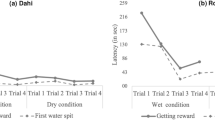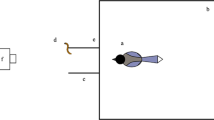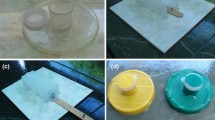Abstract
Apparently sophisticated behaviour during problem-solving is often the product of simple underlying mechanisms, such as associative learning or the use of procedural rules. These and other more parsimonious explanations need to be eliminated before higher-level cognitive processes such as causal reasoning or planning can be inferred. We presented three Bornean orangutans with 64 trial-unique configurations of a puzzle-tube to investigate whether they were able to consider multiple obstacles in two alternative paths, and subsequently choose the correct direction in which to move a reward in order to retrieve it. We were particularly interested in how subjects attempted to solve the task, namely which behavioural strategies they could have been using, as this is how we may begin to elucidate the cognitive mechanisms underpinning their choices. To explore this, we simulated performance outcomes across the 64 trials for various procedural rules and rule combinations that subjects may have been using based on the configuration of different obstacles. Two of the three subjects solved the task, suggesting that they were able to consider at least some of the obstacles in the puzzle-tube before executing action to retrieve the reward. This is impressive compared with the past performances of great apes on similar, arguably less complex tasks. Successful subjects may have been using a heuristic rule combination based on what they deemed to be the most relevant cue (the configuration of the puzzle-tube ends), which may be a cognitively economical strategy.





Similar content being viewed by others
Notes
It should be noted that this does not necessarily imply any sort of phenomenal consciousness; that is, the subjective ‘feel’ of an experience (Carruthers 1998).
References
Bard KA (1995) Sensorimotor cognition in young feral orangutans (Pongo-Pygmaeus). Primates 36:297–321
Biro D, Matsuzawa T (1999) Numerical ordering in a chimpanzee (Pan troglodytes): planning, executing, and monitoring. J Comp Psychol 113:178–185
Brewer SM, McGrew WC (1990) Chimpanzee use of a tool-set to get honey. Folia Primatol 54:100–104
Byrne RW (1997) The technical intelligence hypothesis: an additional evolutionary stimulus to intelligence? In: Whiten A, Byrne RW (eds) Machiavellian intelligence II: extensions and evaluations. Cambridge University Press, Cambridge, pp 289–311
Byrne RW, Corp N, Byrne JME (2001) Estimating the complexity of animal behaviour: how mountain gorillas eat thistles. Behaviour 138:525–557
Cacchione T, Call J (2010) Intuitions about gravity and solidity in great apes: the tubes task. Dev Sci 13:320–330
Carruthers P (1998) Natural theories of consciousness. Eur J Philos 6:203–222
Cheke LD, Bird CD, Clayton NS (2011) Tool-use and instrumental learning in the Eurasian jay (Garrulus glandarius). Anim Cogn 14:441–455
Chevalier-Skolnikoff S, Galdikas BMF, Skolnikoff AZ (1982) The adaptive significance of higher intelligence in wild orang-utans: a preliminary report. J Hum Evol 11:639–652
Chittka L, Jensen K (2011) Animal cognition: concepts from apes to bees. Curr Biol 21:116–119
Corp N, Byrne RW (2002) Leaf processing by wild chimpanzees: physically defended leaves reveal complex manual skills. Ethology 108:673–696
Crawley MJ (2007) The R book. Wiley, Chichester
D’Mello S, Franklin S (2011) A cognitive model’s view of animal cognition. Curr Zool 57:499–513
Dunbar RIM, McAdam MR, O’Connell S (2005) Mental rehearsal in great apes (Pan troglodytes and Pongo pygmaeus) and children. Behav Proc 69:323–330
Epstein R, Kirshnit CE, Lanza RP, Rubin LC (1984) ‘Insight’ in the pigeon: antecedents and determinants of an intelligent performance. Nature 308:61–62
Fedor A, Skollar G, Szerencsy N, Ujhelyi M (2008) Object permanence tests on gibbons (Hylobatidae). J Comp Psychol 122:403–417
Fragaszy D, Johnson-Pynn J, Hirsh E, Brakke K (2003) Strategic navigation of two-dimensional alley mazes: comparing capuchin monkeys and chimpanzees. Anim Cogn 6:149–160
Fragaszy DM, Kennedy E, Murnane A, Menzel D, Brewer G, Johnson-Pynn J, Hopkins W (2009) Navigating two-dimensional mazes: chimpanzees (Pan troglodytes) and capuchins (Cebus apella sp.) profit from experience differently. Anim Cogn 12:491–504
Galdikas BMF (1982) Orang-utan tool-use at Tanjung Puting Reserve, Central Indonesian Borneo (Kalimantan Tengah). J Hum Evol 11:19–33
Girndt A, Meier T, Call J (2008) Task constraints mask great apes’ ability to solve the trap-table task. J Exp Psychol Anim B 34:54–62
Hihara S (2003) Rapid learning of sequential tool use by macaque monkeys. Physiol Behav 78:427–434
Hunt GR, Rutledge RB, Gray RD (2006) The right tool for the job: what strategies do wild New Caledonian crows use? Anim Cogn 9:307–316
Kacelnik A (2009) Tools for thought or thought for tools? PNAS 106:10071–10072
Kaller CP, Rahm B, Köstering L, Unterrainer JM (2011) Reviewing the impact of problem structure on planning: a software tool for analyzing tower tasks. Behav Brain Res 216:1–8
Kuczaj SA, Gory JD, Xitco MJ (2009) How intelligent are dolphins? A partial answer based on their ability to plan their behavior when confronted with novel problems. Jpn J Anim Psychol 59:99–115
Lethmate J (1979) Instrumental behaviour of zoo orang-utans. J Hum Evol 8:741–744
Lethmate J (1982) Tool-using skills of orang-utans. J Hum Evol 11:49–64
Martin-Ordas G, Call J (2009) Assessing generalization within and between trap tasks in the great apes. Int J Comp Psychol 22:43–60
Martin-Ordas G, Call J, Colmenares F (2008) Tubes, tables and traps: great apes solve two functionally equivalent trap tasks but show no evidence of transfer across tasks. Anim Cogn 11:423–430
Melis AP, Warneken F, Jensen K, Schneider AC, Call J, Tomasello M (2011) Chimpanzees help conspecifics obtain food and non-food items. Proc R Soc B 278:1405–1413
Mitchell P, Currie G, Ziegler F (2009) Two routes to perspective: Simulation and rule-use as approaches to mentalizing. Brit J Dev Psychol 27:513–543
Miyata H, Fujita K (2008) Pigeons (Columba livia) plan future moves on computerized maze tasks. Anim Cogn 11:505–516
Miyata H, Gajdon GK, Huber L, Fujita K (2011) How do keas (Nestor notabilis) solve artificial-fruit problems with multiple locks? Anim Cogn 14:45–58
Mulcahy NJ, Call J (2006) How great apes perform on a modified trap-tube task. Anim Cogn 9:193–199
Pan J, Kennedy EH, Pickering T, Menzel CR, Stone BW, Fragaszy DM (2011) Development of maze navigation by tufted capuchins (Cebus apella). Behav Proc 86:206–215
Povinelli DJ (2000) Folk physics for apes: the Chimpanzee's theory of how the world works. Oxford University Press, Oxford
Povinelli DJ, Cant JGH (1995) Arboreal clambering and the evolution of self-conception. Q Rev Biol 70:393–421
Russon AE (2010) Life history: the energy-efficient orangutan. Curr Biol 20:981–983
Santos LR, Rosati A, Sproul C, Spaulding B, Hauser MD (2005) Means-means-end tool choice in cotton-top tamarins (Saguinus oedipus): finding the limits on primates’ knowledge of tools. Anim Cogn 8:236–246
Seed AM, Byrne RW (2010) Animal tool-use. Curr Biol 20:R1032–R1039
Seed AM, Tebbich S, Emery NJ, Clayton NS (2006) Investigating physical cognition in rooks, Corvus frugilegus. Curr Biol 16:697–701
Seed AM, Call J, Emery NJ, Clayton NS (2009) Chimpanzees solve the trap problem when the confound of tool-use is removed. J Exp Psychol Anim B 35:23–34
Shah A, Oppenheimer D (2008) Heuristics made easy: an effort-reduction framework. Psych Bull 134:207–222
Sloman A (1999) What sort of architecture is required for a human-like agent? In: Wooldridge M, Rao AS (eds) Foundations of rational agency. Kluwer Academic Publishers, Dordrecht, pp 35–52
Suddendorf T, Whiten A (2001) Mental evolution and development: evidence for secondary representation in children, great apes, and other animals. Psych Bull 127:629–650
Taylor AH, Hunt GR, Holzhaider JC, Gray RD (2007) Spontaneous metatool use by New Caledonian crows. Curr Biol 17:1504–1507
Taylor AH, Hunt GR, Medina FS, Gray RD (2009) Do New Caledonian crows solve physical problems through causal reasoning? Proc R Soc B 276:247–254
Taylor AH, Elliffe D, Hunt GR, Gray RD (2010) Complex cognition and behavioural innovation in New Caledonian crows. Proc R Soc B 277:2637–2643
Tebbich S, Seed AM, Emery NJ, Clayton NS (2007) Non-tool-using rooks, Corvus frugilegus, solve the trap-tube problem. Anim Cogn 10:225–231
Thorpe SKS, Crompton RH (2005) Locomotor ecology of wild orangutans (Pongo pygmaeus abelii) in the Gunung leuser ecosystem, Sumatra, Indonesia: a multivariate analysis using log-linear modeling. Am J Phys Anthropol 127:58–78
Thorpe SKS, Crompton RH (2006) Orangutan positional behavior and the nature of arboreal locomotion in Hominoidea. Am J Phys Anthropol 131:384–401
Thorpe SKS, Crompton RH, Alexander RMcN (2007) Orangutans use compliant branches to lower the energetic cost of locomotion. Biol Lett 3:253–256
Thorpe SKS, Holder R, Crompton RH (2009) Orangutans employ unique strategies to control branch flexibility. PNAS 106:12646–12651
Visalberghi E, Limongelli L (1994) Lack of comprehension of cause-effect relations in tool-using capuchin monkeys (Cebus apella). J Comp Psych 108:15–22
Vlamings PHJM, Hare B, Call J (2010) Reaching around barriers: the performance of the great apes and 3–5-year-old children. Anim Cogn 13:273–285
Willats P (1989) Development of problem-solving in infancy. In: Slater A, Bremmer G (eds) Infant development. Erlbaum, Hillsdale, pp 143–182
Wimpenny JH, Weir AAS, Clayton L, Rutz C, Kacelnik A (2009) Cognitive processes associated with sequential tool use in New Caledonian crows. PloS ONE 4:e6471
Acknowledgments
We thank Apenheul Primate Park (Netherlands) for granting permission for scientific research and generously giving their time, support and valuable knowledge. Special thanks go to Rudy Berends, Leo Hulsker, Bianca Klein and Frank Rietkerk. We are also grateful to four anonymous reviewers whose comments contributed to the improvement of this manuscript. This study was funded by a Natural Environment Research Council studentship to E.C.T.
Conflict of interest
The authors declare that they have no conflict of interest.
Ethical standards
The experiments reported here comply with the current laws of the country (Netherlands) in which they were performed.
Author information
Authors and Affiliations
Corresponding author
Additional information
Susannah K. S. Thorpe and Jackie Chappell were Joint senior authors.
Electronic supplementary material
Below is the link to the electronic supplementary material.
Supplementary material 1 (MPG 2244 kb)
Supplementary material 2 (MPG 4840 kb)
Supplementary material 3 (MPG 8132 kb)
Supplementary material 4 (MPG 3522 kb)
Rights and permissions
About this article
Cite this article
Tecwyn, E.C., Thorpe, S.K.S. & Chappell, J. What cognitive strategies do orangutans (Pongo pygmaeus) use to solve a trial-unique puzzle-tube task incorporating multiple obstacles?. Anim Cogn 15, 121–133 (2012). https://doi.org/10.1007/s10071-011-0438-x
Received:
Revised:
Accepted:
Published:
Issue Date:
DOI: https://doi.org/10.1007/s10071-011-0438-x




